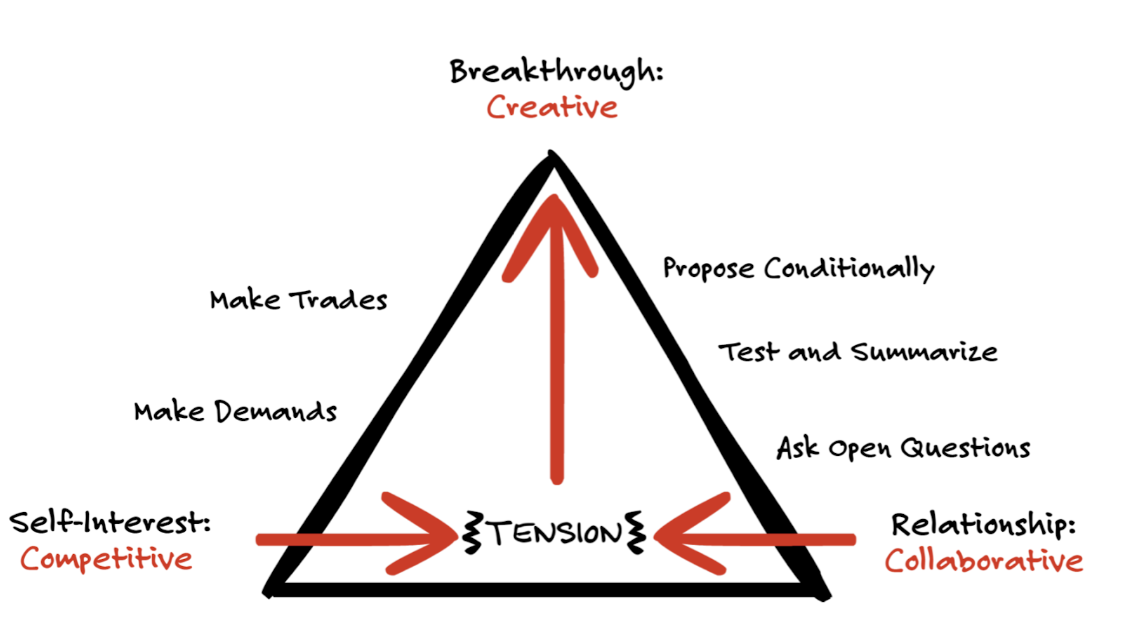You’ve likely heard that pressure makes diamonds, and in much the same way, tension makes creative solutions.
The best negotiators are able to masterfully utilize various skills in their toolbox to lead negotiations and get more of what they want. RED BEAR’s 3-D Negotiation Model postulates that there are three different negotiation dimensions that lead to successful negotiations: Collaborative, Competitive, and Creative. These three dimensions work together in varying doses and help negotiators get more value from their negotiations, while simultaneously building the foundation for a productive long-term relationship.
Negotiations are centered around Tension
The Competitive Dimension focuses on your self-interest and that of the party you are representing. The Competitive Dimension means protecting your desires, looking out for yourself, and occasionally playing hardball to not give up ground without gaining anything in exchange. Often, this dimension focuses on a single or small few negotiables, such as money or terms. A negotiator that takes the Competitive Dimension to its extremes ends up with a “win-lose” mindset where every win you get comes at the expense of the other party.
The Collaborative Dimension is all about facilitating communication in hopes of building a productive relationship and opening the playing field by searching for multiple negotiables. Ultimately, the Collaborative Dimension wants to find mutually satisfactory outcomes for the negotiation. A negotiator that takes the Collaborative Dimension to its extremes might end up sacrificing otherwise achievable wins or leaving value on the table for the sake of closing the deal.
The Competitive and Collaborative Dimensions fundamentally act as antagonists to each other, but both need to be utilized to reach a negotiation’s maximum potential. Without the competitive drive for self-interest, the negotiator may give in too quickly, reduce the level of tension, and diminish the chances that new and creative solutions will emerge. Without the collaborative drive for a relationship, negotiators might not be able to engage in the “give and take” needed to generate new ways of looking at the situation. Impasses and bad feelings might emerge.
The natural tension that emerges from these two antagonistic elements actually acts as a positive force that helps nudge negotiations forward that give birth to creative solutions. Tension, however, is a concept that is often hard to grasp for many people. As humans, we’re hardwired to avoid discomfort and tension. In order to give our negotiations the power to transcend your typical run of the mill stagnations without giving up too much of your self-interest, we need to embrace this tension and alchemize it into something productive.
That’s where the Creative Dimension comes into play. When there is a healthy tension between the self-interests of the parties and the desire of both to maintain their relationship, the chances of a creative breakthrough—a truly creative and unanticipated approach to a mutually profitable settlement—increase dramatically.
The Creative Dimension seeks to break through deadlock and potentially find even better solutions that would otherwise be left unexplored.

Tension is that feeling you get when someone puts their foot down and draws a line in the sand, setting a limit. Tension could feel like an uncomfortable knot in your stomach. However, instead of devolving into a bundle of nerves, tension should signal “Game on.”
Use of Negotiation Behaviors to Manage Tension
Once you’ve hit healthy tension, it’s important to use it to keep the momentum of the negotiation moving forward. To do so, you must utilize the five negotiation behaviors as necessary: make demands, make trades, ask open questions, test and summarize, and propose conditionally.
Making demands and making trades are the two behaviors aligned with the Competitive Dimension. They work best when you’re concerned with preserving your self-interest, which tends to happen more frequently when in competitive situations. You make demands when you want to raise a hard issue or set a boundary.
These are best done with simple declarative sentences starting with “I” and setting a time limit, positioning self-interest, and maintaining control. For example, “I need you to eliminate the penalty fee on all invoices that are between 45 and 60 days overdue, effective immediately before we can get the contract to legal.”
Asking open questions, testing and summarizing, and proposing conditionally align with the Collaborative Dimension and aim to get all parties on the same page while pushing the negotiation forward and building the relationship. Open questions tend to get the other party talking and sharing information that could lead to more creative opportunities later. These are questions that aim to elicit real information and not just “yes or no” answers with the goal of uncovering the underlying motivation and true needs of the other party.
Testing and summarizing is particularly useful when you need to clarify understanding and confirm areas of agreement and disagreement. For example, “Let me see if I understand your position. You’ll waive all future penalties on overdue invoices for one year if we will pay off all standing invoices by the end of the month?”
Proposing conditionally is used to break through stagnation, generate creative solutions, and to get all parties thinking outside the box. A conditional proposal is generally a question in hypothetical terms framed to prompt creative thinking and dialogue. For example, “What if we can pay within two days of delivery instead of ten?”
Final Thoughts
Skilled negotiators thrive in tension and don’t let it distract from utilizing all three dimensions and five behaviors as necessary. Like everything, working with tension requires practice, but once you’ve unlocked the ability to use healthy tension to build long-term productive relationships while simultaneously landing on favorable terms, you’ll have leveled up significantly.
RED BEAR Negotiation Company is a global performance improvement firm dedicated to maximizing the profitability of the agreements negotiated with customers, suppliers, partners, and colleagues. If you’re interested in empowering your team with world-class negotiation skills, contact us or click here for more information.

